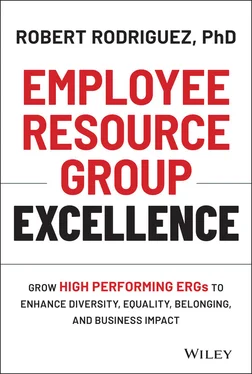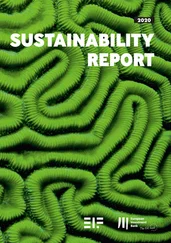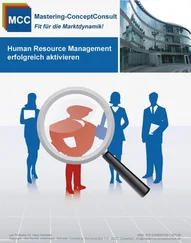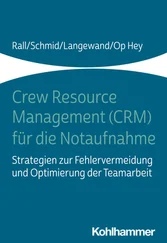However, companies do not want to create a scenario where the ERGs are helping to groom leaders only to have those leaders leave the employee resource group. Organizations need leadership continuity in order for these groups to have sustainable long‐term success. And this has resulted in the greater alignment of ERGs with talent management.
Alignment with talent management initiatives often involves ensuring that strong performers are in the leadership roles of the ERGs. If the employee resource group does not have a strong leader, companies are now starting to appoint someone to the role of ERG leader who is more capable. The person appointed is increasingly someone who is already deemed a high performer or someone with tremendous potential.
The reasons for the need to appoint strong performers into ERG leadership roles are twofold. First, companies realize that employee resource groups tend to be only as strong as their leader. Second, the demand for strong ERG leaders often exceeds the supply. And this has led to greater ERG alignment with talent management. This will be explored further in Chapter 11.
Underutilized Business Assets
There has been much fanfare about turning “employee resource groups” into “business resource groups.” The thinking goes that ERGs cannot just be the “food, flag, and fun folks” who are primarily focused on the social aspects of employee resource groups. Organizations want ERGs to have a broader value proposition. The goal is not to eliminate the social aspects of employee resource groups because we still want them to celebrate over food, waive their diversity flag, and hold events that are indeed fun. But we need to encourage ERGs to also add value in a more holistic way. This broader value proposition is something that I have been advocating for many years as a component of the definition of ERG excellence.
Yet, in my experience, ERGs are not the ones to blame if they do not have a more direct impact on helping an organization meet their goals. In working with thousands of employee resource groups for the past several decades, these ERGs want to have a direct impact on the organization. They are often more than ready, willing, and able to support business initiatives. The real problem exists with the organization itself. Surprisingly, organizations are woefully inadequate at leveraging their ERGs for business impact. This results in employee resource groups being an underutilized business asset still today. We will explore this phenomenon, and how to overcome it, in Chapter 8.
In my experience, ERGs have long struggled with articulating the value they provide back to their members and to the organization as a whole. Any measures of success an employee resource group touts typically involves a listing of their activities and membership size. ERGs are quick to tell you how many members they have, across how many locations, and how many events they held in the past year. While these numbers help, they do not adequately convey to others how successful the ERGs are. The lack of metrics is one reason that middle managers often do not give ERGs the credibility and respect that they deserve. What is needed by employee resource groups is a more sophisticated measurement strategy, a strategy that not only highlights the ERG's activities, but also the impact of those activities.
ERGs need to have metrics that help them tell their story and inform others why they exist. I call these “ERG metrics‐that‐matter.” Without such metrics, employee resource groups are unable to track their progress or compare themselves to benchmark standards. ERGs are not solely to blame for this lack of metrics. Organizations are often reluctant to share data and information that ERGs can use to establish such metrics. Also, not having metrics makes it impossible to have a scorecard or dashboard where an ERG can easily share their results. If an ERG does have a scorecard or dashboard, it tends to usually be a qualitative analysis of their activity as opposed to a quantitative report on their impact. The lack of a measurement strategy is how many ERGs are operating today and we will explore this further in Chapter 10.
One reason for greater alignment between ERGs and talent management is that ERGs do not typically engage in succession planning. The purpose of succession planning is to make sure an ERG always has the right leaders in place should a leadership change happen quickly or unexpectedly. The lack of succession planning is one reason that some employee resource groups struggle to sustain early success.
The Covid‐19 pandemic had a tremendous impact on ERG leadership. Some existing ERG leaders left their roles because they had to concentrate solely on their day job. Some left because they were downsized or quit their jobs to focus on their family. And some left their role as an ERG leader because they simply could not run an employee resource group under the challenging Covid‐19 work environment. Those who were able to remain in their ERG leadership role often indicated that the search for the next ERG leader should begin. These individuals burned out due to all the heavy lifting they had to do to run an employee resource group effectively during the dynamic and unprecedented period that began in 2020.
All this sudden and concentrated leadership change at the top of many ERGs has exposed insufficient pipelines of new potential ERG leaders. Not enough ERG members have been groomed to assume leadership roles of an employee resource group. Additionally, companies have not adequately made ERG leadership roles highly desired, resulting in fewer employees wanting these roles. This succession planning crisis, and all its implications, will be analyzed in Chapter 5.
Skeptical Middle Management
One thing that has not changed much in the past 10–15 years is that middle managers at organizations still are mostly skeptical about the value of employee resource groups. These middle managers struggle to see the benefits that ERGs provide. Some are still convinced that ERGs are divisive as opposed to being entities that promote unity and inclusion.
I once spoke to a focus group consisting of managers at one company who saw a lack of engagement by middle management as a key obstacle for their employee resource groups. It was difficult to blame some middle managers for not being more supportive of ERGs because they simply didn't know what these groups were about. Some were not aware they even existed or lacked clarity as to what ERGs do. Given such lack of awareness about ERGs, it was easy to see why there were not more supported.
Other middle managers were more transparent and shared their concerns about employees spending too much time on ERG activities and not enough time on their regular job. These managers shared their reality of having too few resources to meet challenging goals and that they need their employees focused on their work. And still others conveyed the impracticality of allowing their employees to attend ERG meetings or events when it required their employees, who were mostly hourly, to be at their desks answering calls or on the production line putting out product.
Regardless of the reason, ERGs need more active engagement from middle management. They need managers to support employees who wish to participate in employee resource group activities. Better yet, ERGs need more middle managers themselves to join employee resource groups. But in order for this to happen, both employee resource groups and middle managers have to do their part.
Employee resource groups need to do a better job of defining their value proposition (including metrics‐that‐matter) to middle management. Employee resource groups must convey how and why their activities are relevant to middle managers. Conversely, middle management should be more proactive in finding out what ERGs are all about and why these groups are prevalent across corporate America and what employees get out of their involvement. However, until both stakeholder groups accomplish this, the lack of middle management support is a reality that ERGs must contend with for the foreseeable future. The strategies highlighted throughout this book will hopefully convince more middle managers of their importance in endorsing and advocating for ERGs. The lack of middle manager support will be analyzed further in Chapter 2.
Читать дальше












